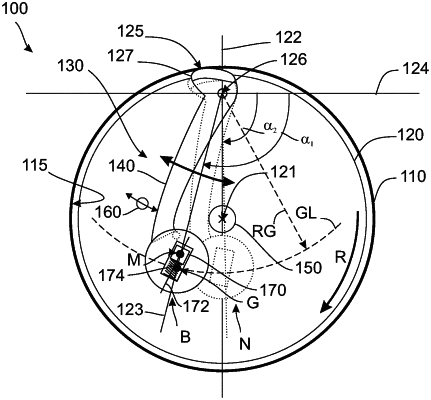| CPC A01K 89/01557 (2015.05) [B65H 75/406 (2013.01); B65H 75/4447 (2013.01); F16D 59/00 (2013.01); B65H 2403/725 (2013.01); B65H 2701/355 (2013.01); F16D 2127/002 (2013.01)] | 15 Claims |

|
1. A rotational friction brake actuated and regulated by a rate of change of angular speed, the rotational friction brake comprising:
a first body having a first friction surface,
a second body rotationally attached to the first body, the second body being configured to rotate around a rotational center axis of the second body,
an actuator arrangement configured to move a second friction surface into frictional engagement with the first friction surface, the second friction surface being configured to rotate together with the second body, the actuator arrangement comprising:
an actuator arm being configured to rotate together with the second body and being pivotably attached to the second body in a pivot point, wherein the pivot point is eccentrically offset to the rotational center axis along a radial axis,
wherein the actuator arrangement has a geometrical mass center, the pivot point and the geometrical mass center defining an actuator axis,
wherein the actuator arrangement further has a radius of gyration relative to the pivot point as seen in the actuator arrangement's rotation together with the second body, the radius of gyration being longer than a distance between the pivot point and the rotational center axis,
wherein the actuator axis intersects the pivot point, forming an angle to a normal axis, the normal axis being defined perpendicular to the radial axis through the pivot point, and
wherein the second friction surface is arranged to frictionally engage with the first friction surface for values of the angle being equal to, or larger than, a first angle, and
a stop member configured to limit the movement of the actuator arrangement relative to the second body, such that the angle is limited to a minimum angle larger than a second angle, at which angle the actuator arrangement is in a non-braking position,
wherein the first angle is larger than the second angle, and wherein the second angle is within the range from 80° to 100°, and
wherein the actuator arrangement has an internal flexibility which allows a shape of the actuator arrangement to depend on centrifugal forces acting thereon, said internal flexibility being configured such that:
(a) the first angle depends on the angular speed of the rotating second body, and/or
(b) the second angle depends on the angular speed of the rotating second body, and/or
(c) a portion of the actuator arrangement, when being in the non-braking position, makes contact with a portion of the first and/or second bodies in response to the angular speed of the second body exceeding an angular speed threshold, thereby transmitting a force from said contact to the actuator arm so as to facilitate actuation of the brake,
wherein the actuator arrangement is configured to move in relation to the second body from the non-braking position to a braking position at which the second friction surface comes into frictional engagement with the first friction surface so as to actuate the rotational friction brake.
|